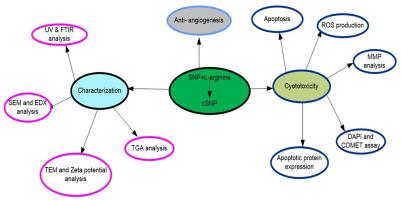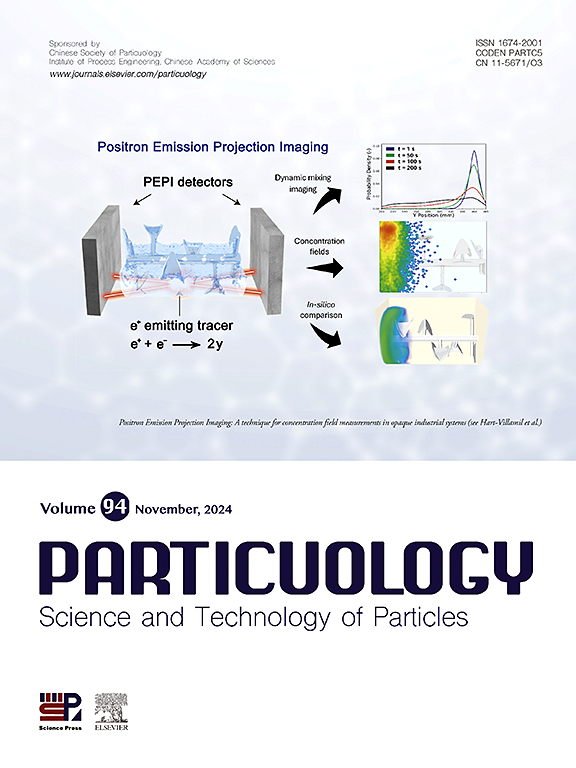Bioengineered silver nanoparticles induced apoptosis through upregulation of caspase 3 and caspase 8 proteins in breast adenocarcinoma MDA-MB-231 cells and impede angiogenesis
IF 4.1
2区 材料科学
Q2 ENGINEERING, CHEMICAL
引用次数: 0
Abstract
In recent years, a lot of research has been done on silver nanoparticles (SNP) due to their numerous applications in the biomedical, pharmaceutical, and drug delivery industries. In this present study SNP were green synthesized using Melicope lunu-ankenda (M. lunu-ankenda) leaf extract. The addition of AgNO3 causes a color change. L-arginine addition results in further colour changes confirming conjugation. A UV–Vis spectrophotometric examination showed that the absorption peak for SNP was 435 nm, while the peak for L-arginine SNP (cSNP) was 422 nm. FTIR analysis confirmed the association of amides and amines with nanoparticles. The spherical nature of the silver was disclosed by SEM, and its elemental character is verified by EDS. The thermal stability of the nanoparticles is determined by TGA analysis, while TEM examination verifies their spherical shape. Using the MTT assay, these cSNP exhibited outstanding toxicity analysis (IC50 38.72 μg/ml) against MDA-MB-231 cells. These cSNP causes damage to the mitochondria (JC1 staining), which causes oxidative stress and the production of ROS with 83% of DCF expression in cancer cells. Furthermore, as demonstrated by the Comet assay and DAPI, these cSNP cause good DNA damage in the treated cells. Additionally, using flow cytometry, cSNPs potentially trigger apoptosis by triggering the expression of caspase 3 and caspase 8 proteins. Additionally, through CAM, cSNP demonstrated strong anti-angiogenesis activity by reducing the number of blood vessel branches. These findings suggest that cSNP may be crucial for drug delivery and cancer treatment.

生物工程银纳米粒子通过上调乳腺癌 MDA-MB-231 细胞中的 caspase 3 和 caspase 8 蛋白诱导细胞凋亡并阻碍血管生成
近年来,由于银纳米粒子(SNP)在生物医学、制药和给药行业的大量应用,人们对其进行了大量研究。本研究利用Melicope lunu-ankenda(M. lunu-ankenda)叶提取物绿色合成了SNP。加入 AgNO3 会导致颜色变化。加入 L-精氨酸后,颜色进一步变化,证实了共轭作用。紫外可见分光光度检测显示,SNP 的吸收峰为 435 纳米,而 L-精氨酸 SNP(cSNP)的吸收峰为 422 纳米。傅立叶变换红外光谱分析证实了酰胺和胺与纳米颗粒的结合。扫描电镜显示了银的球形性质,而 EDS 则验证了其元素特性。TGA 分析确定了纳米颗粒的热稳定性,而 TEM 检验则验证了其球形形状。通过 MTT 试验,这些 cSNP 对 MDA-MB-231 细胞的毒性分析(IC50 为 38.72 μg/ml)非常出色。这些 cSNP 会对线粒体造成损伤(JC1 染色),从而导致氧化应激和 ROS 的产生,在癌细胞中的 DCF 表达为 83%。此外,正如彗星试验和 DAPI 所显示的,这些 cSNP 会对处理过的细胞造成严重的 DNA 损伤。此外,通过流式细胞术,cSNPs 还可通过触发 caspase 3 和 caspase 8 蛋白的表达来引发细胞凋亡。此外,通过 CAM,cSNP 还能减少血管分支的数量,从而表现出很强的抗血管生成活性。这些发现表明,cSNP 可能是药物输送和癌症治疗的关键。
本文章由计算机程序翻译,如有差异,请以英文原文为准。
求助全文
约1分钟内获得全文
求助全文
来源期刊

Particuology
工程技术-材料科学:综合
CiteScore
6.70
自引率
2.90%
发文量
1730
审稿时长
32 days
期刊介绍:
The word ‘particuology’ was coined to parallel the discipline for the science and technology of particles.
Particuology is an interdisciplinary journal that publishes frontier research articles and critical reviews on the discovery, formulation and engineering of particulate materials, processes and systems. It especially welcomes contributions utilising advanced theoretical, modelling and measurement methods to enable the discovery and creation of new particulate materials, and the manufacturing of functional particulate-based products, such as sensors.
Papers are handled by Thematic Editors who oversee contributions from specific subject fields. These fields are classified into: Particle Synthesis and Modification; Particle Characterization and Measurement; Granular Systems and Bulk Solids Technology; Fluidization and Particle-Fluid Systems; Aerosols; and Applications of Particle Technology.
Key topics concerning the creation and processing of particulates include:
-Modelling and simulation of particle formation, collective behaviour of particles and systems for particle production over a broad spectrum of length scales
-Mining of experimental data for particle synthesis and surface properties to facilitate the creation of new materials and processes
-Particle design and preparation including controlled response and sensing functionalities in formation, delivery systems and biological systems, etc.
-Experimental and computational methods for visualization and analysis of particulate system.
These topics are broadly relevant to the production of materials, pharmaceuticals and food, and to the conversion of energy resources to fuels and protection of the environment.
 求助内容:
求助内容: 应助结果提醒方式:
应助结果提醒方式:


